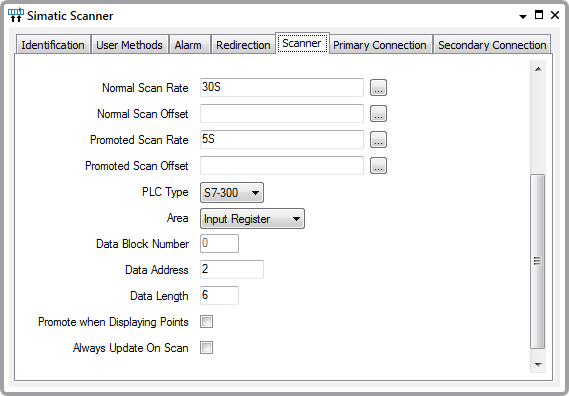Use these fields on the Scanner tab to define properties such as the scan rate, scan offset, and the type of data that is to be scanned.
You can also specify whether the scan rate is increased whenever any of the associated points are displayed on a client (see Define Whether a Scanner is Promoted While its Points are on Display in the ClearSCADA Guide to Simple Drivers).
For information on fields that are available for many scanners, see Define the Scan Rate in the ClearSCADA Guide to Simple Drivers. Fields that are specific to Simatic S7 scanners are explained below:

- PLC Type—Use this combo box to specify the series of Simatic S7 PLC that the Scanner is to scan. Choose S7-200, S7-300, or S7-400, as appropriate.
(Remember that for serial communications the associated Channel’s Connection Type also varies, depending on the type of PLC—for more information, see Communicating with Simatic S7 PLCs.)
- Area—Use this combo box to specify the area of memory that the Scanner is to scan in the Simatic S7-200, S7-300, or S7-400 series PLC. The entries that you can choose from vary, depending on the PLC Type, but include a combination of the following:
- Input Register—The read-only memory area for physical inputs. This area can include both digital and analog input data.
- Output Register—The read/write memory area for physical outputs. This area can include both digital and analog output data.
- Data Block—The write-only memory area for the variables that are used in the PLC’s internal logic programs.
- Flags/Markers—The memory area for flag data. Applies to Simatic S7-300 and S7-400 series PLCs only.
- Timers—The memory area for timer data. Applies to Simatic S7-300 and S7-400 series PLCs only.
- Counters—The memory area for counter data. Applies to Simatic S7-300 and S7-400 series PLCs only.
- Analog Inputs—The read-only memory area for analog inputs. Applies to Simatic S7-200 series PLCs only.
- Analog Outputs—The read/write memory area for analog outputs. Applies to Simatic S7-200 series PLCs only.
- IEC Timers—The memory area for timer data that is used in IEC programs. Applies to Simatic S7-200 series PLCs only.
- IEC Counters—The memory area for counter data that is used in IEC programs. Applies to Simatic S7-200 series PLCs only.
- Special Memory—The memory area used storing for PLC status information. Applies to Simatic S7-200 series PLCs only.
- Data Block Number—Applies if the Area of memory that is being scanned is merely specified as a Data Block (see above). Use this field to specify the number of the block of data that is to be scanned.
The size of the Data Block memory area varies, depending on the model of PLC—for more information, see the documentation supplied with the Simatic S7 PLC.
- Data Address—Specify the position in the Simatic S7 register from which the scanner is to start scanning data, from within the specified memory Area (see above). This is the number of bytes offset into the Area.
Be aware that the size of each memory area varies, depending on the model of PLC.
- Data Length—Enter the number of registers that are to be scanned. The registers each comprise one byte (8 bits) and are scanned as a block, starting with the register specified in the Data Address field, above.
Be aware that the size of each memory area, and therefore the number of registers, varies, depending on the model of PLC— for more information, see the documentation supplied with the Simatic S7 PLC.
- Promote when Displaying Points—Use this check box to specify whether you want the ClearSCADA server to give scanning preference to a scanner whenever any of its points are displayed on a client.
For more information, see Define Whether a Scanner is Promoted While its Points are on Display in the ClearSCADA Guide to Simple Drivers.
- Always Update on Scan—Use this check box to indicate whether you want to use the scanner’s updates as a trigger for a Logic program (see Define Whether a Scanner is Used to Trigger Logic in the ClearSCADA Guide to Simple Drivers).